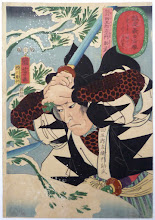So, what did Frank Mentzer have to say about the dwarf as a fantasy trope?
They're pretty much described as what has become the stereotype. Take Tolkien and Snow White, mix well, there you go. Short, stubborn, practical, hard-working, hard drinking, rowdy little dudes. And their women-folk have beards, don'chaknow.
 As a class, we're told that they should behave like Fighters, so go read the Fighter class entry for tips on how to play. We're given a rundown of their basic abilities, including their restriction to small or "normal" size weapons. Of course, it's not until much later, in the Masters set or maybe the RC that we finally get anything like weapon size categories. The text itself prohibits two-handed swords and longbows. Lances and pole arms are allowed (confirmation of the lance comes in the Expert Set, where Dwarves are allowed to make a charge for double damage with a lance).
As a class, we're told that they should behave like Fighters, so go read the Fighter class entry for tips on how to play. We're given a rundown of their basic abilities, including their restriction to small or "normal" size weapons. Of course, it's not until much later, in the Masters set or maybe the RC that we finally get anything like weapon size categories. The text itself prohibits two-handed swords and longbows. Lances and pole arms are allowed (confirmation of the lance comes in the Expert Set, where Dwarves are allowed to make a charge for double damage with a lance).One thing I notice that's lacking is explicitly pointing out that Dwarves have amazing saving throw scores. It's really their biggest advantage, IMO. And it's something I never actually paid any attention to until much later. Maybe my brother noticed it way back when? Nah, I think he just liked the concept.
For special abilities, we get a concise description of infravision (repeated on the next page for the Elf class). If it's hot, it's red. Cold, blue. Room temperature, it can faintly be seen. 60' range. Simple.
For the detection abilities, we're given a description of the things they can look for, but aside from traps (which is obvious) and to an extent sliding walls (how are they different from secret doors?), it's not obvious why sloping passages or new constructions would be relevant or not. The rules were formed with the megadungeon environment in mind, but by the time these rules were written, the lair or scenario dungeon style was becoming more popular, so as a beginning DM I didn't take advantage of these abilities in scenario design.
One last interesting note. In the section on level titles, we're told to call the character Rolf the Warrior, not Rolf the Second Level Dwarven Fighter. Yet the class is called Dwarf, not Dwarven Fighter. And the level advancement table puts "Dwarven" before each of the Fighter level titles.






After three years, I finally thought of a comment: it says that dwarf women "have" short beards, not that they "grow" short beards.
ReplyDeleteObviously, dwarven culture has the women wear false beards, sort of like habibs. I imagine that an unmarried dwarf woman wears a beard crafted from her father's hair, but changes to using one made from her husband's beard when she gets married.
There is probably a wedding night tradition where the groom's best man holds him down while his buddies shave him. That's how you tell that a dwarf man just got married. He is clean shaven and looks angry.